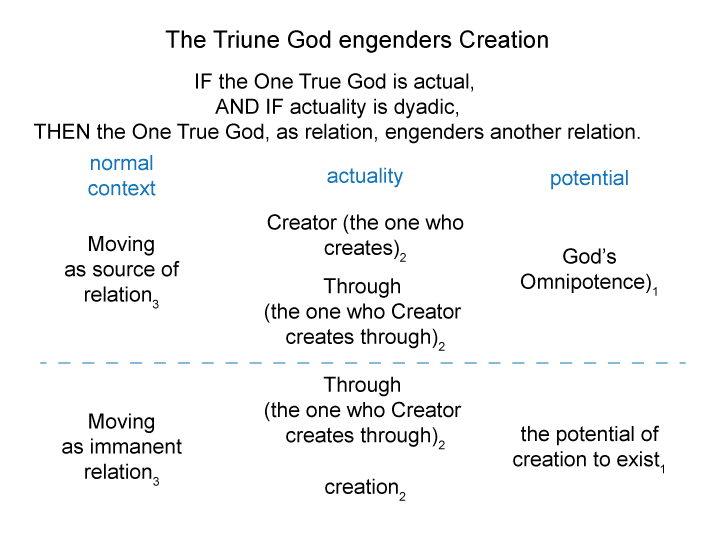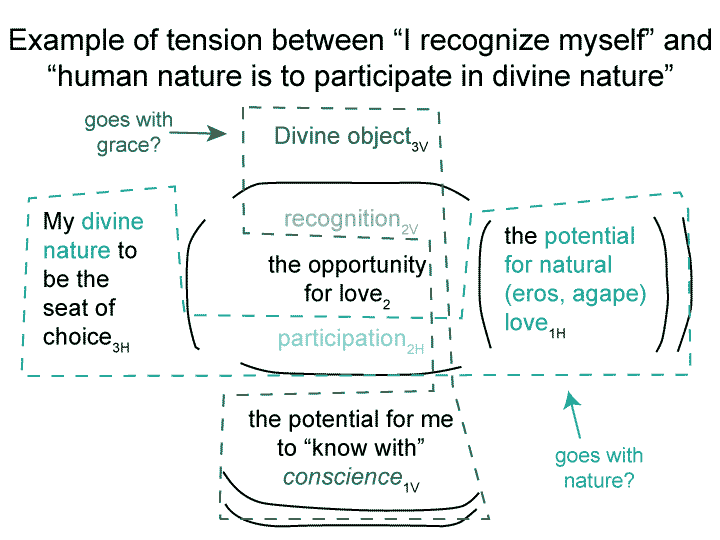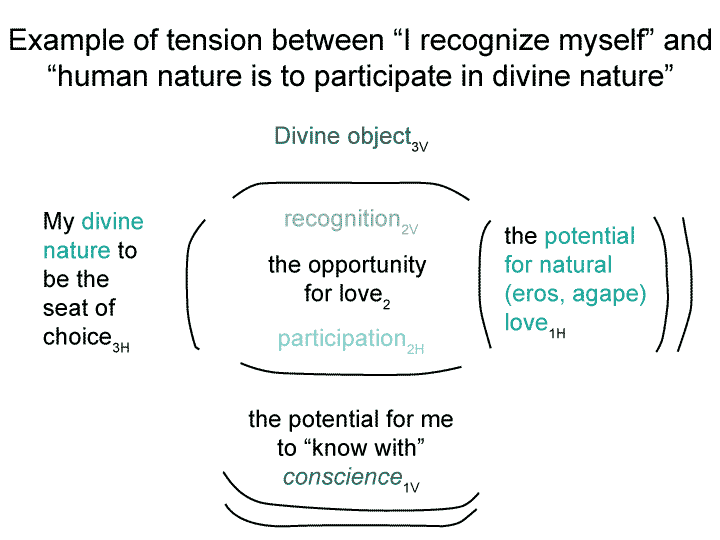Man and Sin by Piet Schoonenberg (1964) 2.2J-2
[I am thrown back to the originating nested forms (2.1 DE, DH and DJ)).
One nested form goes with ‘I recognize myself as an image of God’.
The other nested form goes with ‘my human nature is to participate in the divine nature’.
Neither of these originating nested forms readily separates supernature and nature.
If I had to choose, I would say that the first goes with supernature and the second goes with nature.
But, that still does not satsify.
Even the originating dyad of One True Triune God and Creation does not readily separate into supernature or nature.]
Man and Sin by Piet Schoonenberg (1964) 2.2J-1
Summary of text [comment] page 71
Schoonenberg takes care to avoid this stumbling block:
Grace determines nature.
[The preceding blog offers a suggestion about ‘grace in contrast to nature’.
But the suggestion is not convincing.
The contrast of grace opposed to self-destruction has been confounded with the contrast between supernature and nature.]
Man and Sin by Piet Schoonenberg (1964) 2.2H
[Does the intersecting nested form of recognition and participation capture Schoonenberg’s dichotomy of ‘the whole person and the whole of reality’?
Does it also capture the dichotomy of ‘grace as opposed to nature’?
So far, ‘grace’ is opposed to ‘self-destruction’ as two contradicting ‘states of existence’. The opportunity to love enters the tension between recognition and participation.
Can I formulate a dichotomy of ‘grace in contrast to nature’ from this?]
Man and Sin by Piet Schoonenberg (1964) 2.2G
Summary of text [comment] page 71
What about the sinner who falls in love?
In this example, love must mean eros, rather than agape.
Is it possible for a sinner to become enamored of another?
Yes, but love must involve the whole person.
Love is a positive stand of the whole person with respect to the whole of reality. Love comes from one’s whole heart or it is not love.
[Here, it is clear that Schoonenberg packs more than one definition into the term ‘whole person’.
He has no model that shows how natural and supernatural love implicate one another.
He used the word ‘levels’, as if the two were hierarchical.]
Man and Sin by Piet Schoonenberg (1964) 2.2E
Summary of text [comment] page 70
Schoonenberg continued:
The person cannot say ‘no’ to supernatural love (grace) and “yes” to natural love. Or visa versa.
Man and Sin by Piet Schoonenberg (1964) 2.2D
[To me, the nested forms of recognition and participation model both grace and self-destruction as actualities.
The state of grace is different from the state of self-destruction.
However, Schoonenberg pays tribute to a different contrast.
Grace (as supernatural) is different from nature (as natural).
This concern belongs to modernism. Modernism focuses on actuality and ignores normal context and possibility.
Or maybe, moderns focus on actuality in order to hide their agendas (normal contexts) and manipulations (biasing what is possible).
The contrast between grace and nature is a stand-in for the contrast between the supernatural and the natural.
Does this distinction belong to the realm of actuality?
Or, does it belong to the realms of normal context and possibility?]
Man and Sin by Piet Schoonenberg (1964) 2.2C-1
Summary of text [comment] page 70
[If the model of the nested form carries any lesson it is this:
Independent entities are rarely simple actualities.
Actualities occur in nested forms. They emerge from possibility. They are put into some normal context.
Plus, the actuality may be an intersection. Two actualities combine into one.
If grace and nature are actualities, then what would be their intersection?
Would it be ‘the person’?]



